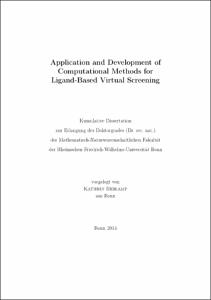Heikamp, Kathrin: Application and Development of Computational Methods for Ligand-Based Virtual Screening. - Bonn, 2014. - Dissertation, Rheinische Friedrich-Wilhelms-Universität Bonn.
Online-Ausgabe in bonndoc: https://nbn-resolving.org/urn:nbn:de:hbz:5n-35820
Online-Ausgabe in bonndoc: https://nbn-resolving.org/urn:nbn:de:hbz:5n-35820
@phdthesis{handle:20.500.11811/6081,
urn: https://nbn-resolving.org/urn:nbn:de:hbz:5n-35820,
author = {{Kathrin Heikamp}},
title = {Application and Development of Computational Methods for Ligand-Based Virtual Screening},
school = {Rheinische Friedrich-Wilhelms-Universität Bonn},
year = 2014,
month = may,
note = {The detection of novel active compounds that are able to modulate the biological function of a target is the primary goal of drug discovery. Different screening methods are available to identify hit compounds having the desired bioactivity in a large collection of molecules. As a computational method, virtual screening (VS) is used to search compound libraries in silico and identify those compounds that are likely to exhibit a specific activity. Ligand-based virtual screening (LBVS) is a subdiscipline that uses the information of one or more known active compounds in order to identify new hit compounds. Different LBVS methods exist, e.g. similarity searching and support vector machines (SVMs). In order to enable the application of these computational approaches, compounds have to be described numerically. Fingerprints derived from the two-dimensional compound structure, called 2D fingerprints, are among the most popular molecular descriptors available.
This thesis covers the usage of 2D fingerprints in the context of LBVS. The first part focuses on a detailed analysis of 2D fingerprints. Their performance range against a wide range of pharmaceutical targets is globally estimated through fingerprint-based similarity searching. Additionally, mechanisms by which fingerprints are capable of detecting structurally diverse active compounds are identified. For this purpose, two different feature selection methods are applied to find those fingerprint features that are most relevant for the active compounds and distinguish them from other compounds. Then, 2D fingerprints are used in SVM calculations. The SVM methodology provides several opportunities to include additional information about the compounds in order to direct LBVS search calculations. In a first step, a variant of the SVM approach is applied to the multi-class prediction problem involving compounds that are active against several related targets. SVM linear combination is used to recover compounds with desired activity profiles and deprioritize compounds with other activities. Then, the SVM methodology is adopted for potency-directed VS. Compound potency is incorporated into the SVM approach through potencyoriented SVM linear combination and kernel function design to direct search calculations to the preferential detection of potent hit compounds. Next, SVM calculations are applied to address an intrinsic limitation of similarity-based methods, i.e., the presence of similar compounds having large differences in their potency. An especially designed SVM approach is introduced to predict compound pairs forming such activity cliffs. Finally, the impact of different training sets on the recall performance of SVM-based VS is analyzed and caveats are identified.},
url = {https://hdl.handle.net/20.500.11811/6081}
}
urn: https://nbn-resolving.org/urn:nbn:de:hbz:5n-35820,
author = {{Kathrin Heikamp}},
title = {Application and Development of Computational Methods for Ligand-Based Virtual Screening},
school = {Rheinische Friedrich-Wilhelms-Universität Bonn},
year = 2014,
month = may,
note = {The detection of novel active compounds that are able to modulate the biological function of a target is the primary goal of drug discovery. Different screening methods are available to identify hit compounds having the desired bioactivity in a large collection of molecules. As a computational method, virtual screening (VS) is used to search compound libraries in silico and identify those compounds that are likely to exhibit a specific activity. Ligand-based virtual screening (LBVS) is a subdiscipline that uses the information of one or more known active compounds in order to identify new hit compounds. Different LBVS methods exist, e.g. similarity searching and support vector machines (SVMs). In order to enable the application of these computational approaches, compounds have to be described numerically. Fingerprints derived from the two-dimensional compound structure, called 2D fingerprints, are among the most popular molecular descriptors available.
This thesis covers the usage of 2D fingerprints in the context of LBVS. The first part focuses on a detailed analysis of 2D fingerprints. Their performance range against a wide range of pharmaceutical targets is globally estimated through fingerprint-based similarity searching. Additionally, mechanisms by which fingerprints are capable of detecting structurally diverse active compounds are identified. For this purpose, two different feature selection methods are applied to find those fingerprint features that are most relevant for the active compounds and distinguish them from other compounds. Then, 2D fingerprints are used in SVM calculations. The SVM methodology provides several opportunities to include additional information about the compounds in order to direct LBVS search calculations. In a first step, a variant of the SVM approach is applied to the multi-class prediction problem involving compounds that are active against several related targets. SVM linear combination is used to recover compounds with desired activity profiles and deprioritize compounds with other activities. Then, the SVM methodology is adopted for potency-directed VS. Compound potency is incorporated into the SVM approach through potencyoriented SVM linear combination and kernel function design to direct search calculations to the preferential detection of potent hit compounds. Next, SVM calculations are applied to address an intrinsic limitation of similarity-based methods, i.e., the presence of similar compounds having large differences in their potency. An especially designed SVM approach is introduced to predict compound pairs forming such activity cliffs. Finally, the impact of different training sets on the recall performance of SVM-based VS is analyzed and caveats are identified.},
url = {https://hdl.handle.net/20.500.11811/6081}
}






